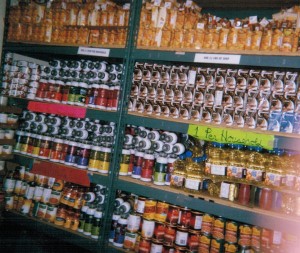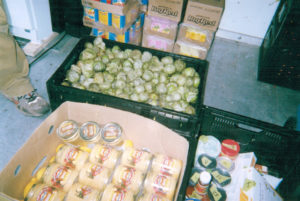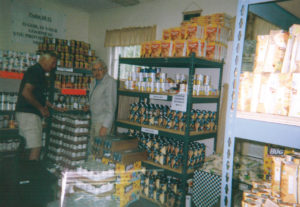5 Important Things You Need to Know About SNAP
“Hunger and income inequality is probably the single biggest issue facing this country.” – Susan Zimet
When you use SNAP, you don’t just get much needed food for your household. When you use SNAP, you create a ripple effect of money for your community. You can use your SNAP card with pride knowing how your purchases will benefit your area.
Here’s how it works: SNAP is federal money. When you use your SNAP card at a local supermarket, you bring it into your community. The grocer uses the money to benefit the local grocery store. This purchase strengthens local businesses.
Are you in a household with senior/disabled members? If so, you may still qualify for SNAP even if you have a higher income. SNAP works for individuals, couples, and families.
Are you paying mandated child support? If so, this money you use to pay child support is not counted toward your income.
You can work and still qualify for SNAP, stretching your food budget every month. When you use SNAP, you more easily afford the nutritious foods you and your family need.
You can shop at a food pantry and still qualify for SNAP.
SNAP can be an important addition to you and your household budget. Apply for this benefit today to help yourself, your household, and your community. How cool is that?
Thanks for reading this blog.
The story is true. The people are real.
Don’t forget to join the email list.
Please refer this article to your preferred social media network and to anyone you know you may benefit from SNAP but is not using it.
Thurman Greco
Can we break down the barriers?
 Starving seniors? Is that too harsh a term?
Starving seniors? Is that too harsh a term?
Let’s ratchet it down: hungry
Or maybe: food insecure. Yeah, that’s better. It sounds better anyway.
Call it what you want, the event is the same. It’s your grandmother or grandfather (for me…I’m certainly a grandmother) caught in a situation where there’s simply not enough food in the house.
MANY OF OUR OLDER RELATIVES QUIETLY CHOOSE BETWEEN BUYING MEDICATIONS OR PUTTING FOOD ON THE TABLE.
The issues with seniors and food insecurity are serious because when seniors no longer have the $$$ to buy the food they need for proper nutrition or when they can no longer pay for the medications they need, they become ill and finally end up being taken care of by their children or they end up in a nursing home.
I know stories about:
The older Woodstock woman living on mashed potatoes.
The woman who ended up in a nursing home when she was cut off from her take out food and didn’t have the resources or physical ability to get to a grocery store.
The older man who lacks funds for enough food and is slowly starving to death.
THERE IS FOOD AVAILABLE FOR SENIORS:
IF they can get to a pantry or connect with a pantry offering take out
IF they will sign up for SNAP (food stamps).
I was recently speaking with a retired man I know:
“Richard, do you get SNAP?”
“No.”
“Why, Richard? SNAP is usually easy to get. All you have to do is apply.”
“Well, I’m getting by alright without it. Let someone else, needier than me, get the $$$.”
“Richard, think about getting SNAP. This is a benefit you paid for. This $$$ is waiting on the table for you. You’re not the kind of guy who leaves $$$ on the table.”
I HAVEN’T CONVINCED HIM YET. However, we’re not through negotiating. As seniors, we’re in a situation where every little bit helps.
THE BARRIERS SENIORS PUT UP TO SNAP ARE GREAT. Seniors resist going to a pantry, soup kitchen, getting SNAP until they simply cannot resist any longer. I know the feeling. We grew up as children and went into adulthood feeling that if we worked hard and paid our taxes, we would end up okay. We worked all our lives with this event in sight and now that we’re here…there simply isn’t enough.
With this event comes the feeling of inadequacy and the self blame. “I must have done something wrong. Here I am living hand-to-mouth. I don’t even have enough $$$ for food. What did I do wrong?”
THERE’S SOMETHING WRONG WHEN A WHOLE GENERATION OF PEOPLE BEGIN BLAMING THEMSELVES. We’re really not totally to blame. The rules have changed. Because we’re retired, we’re not in the rules making game anymore. Retirees by their very nature are disempowered. Whatever happened to the Gray Panthers?
FOOD INSECURITY AMONG SENIORS IS AN EPIDEMIC. People work on both a state and national level to make SNAP more available to seniors. The least we can do is get a card and use it.
Thanks for reading this blog/book.
Please send a comment.
Please refer this article to your preferred social media network.
Don’t forget to join the mailing list.
Peace and food for all.
Thurman Greco
SNAP and Seniors: Many just don’t get it.

Please share this post with any and all seniors you may know. Chances are they might be able to use the information…especially since 1 senior in 7 in our country doesn’t get enough to eat.
Seniors are extremely reluctant to use SNAP, partly because of myths surrounding SNAP.
SNAP Myth #1:
Why apply for SNAP? It’s not worth the hassle. I may not even get much $$$.
SNAP Reality #1:
Most people get more than just a few dollars. Some families receive over $100. But, whatever you get – it all adds up, Over time, you’re going to receive several hundred dollars annually. This $ is yours.
Whether it’s $16 or $160 is not the issue here. This is $$$ that you paid taxes with all these years.
Look at it this way: If you get $16 in SNAP benefits, you can buy eggs, milk, bread, butter. Every penny counts.
Whatever the amount, you are going to be eating better – staying healthier – and using tax dollars that you paid all these years.
SNAP Myth #2:
If I get SNAP, I’ll be taking away food benefits from others who may need them more such as young families with children.
SNAP Reality #2:
There are funds set aside for everyone who qualifies. The funds are federal. No one participating in the SNAP program will be taking away anything from anyone. On the contrary, by using SNAP funds, you will be bringing dollars into your community. You will be helping your town.
Many seniors qualify for SNAP and are not even aware of this benefit.
SNAP Myth #3:
I’ll have to have a face-to-face interview to get on the SNAP roster.
SNAP Reality #3:
Any senior who is ill, has transportation difficulties, has hardships due to living in a rural area, is experiencing prolonged severe weather, or is under the care of another household member does not need to have a face-to-face interview.
In New York State, seniors can be interviewed by phone or with a scheduled home visit.
Basically, the issue here is trust. Seniors sometimes do not trust the process and are afraid of it. Filling out the application can be very challenging for those of us who have cognitive or physical limitations.
A further barrier is language. Many seniors simply do not have the English language skills to apply for SNAP – and they know it. There is another category here: the senior who feels s/he lacks the skills and does not realize that there are professionals who speak the language who can help with the application process.
AND FINALLY
Hunger among seniors is at an epidemic level…especially in New York State. SNAP offers access to a healthy diet which is extremely important for the overall health of seniors.
Thank you for reading this blog/book.
Please refer this article to your preferred social media network.
I hope you found this helpful. Please leave your comments below and check out other posts.
Don’t forget to join the email list.
Peace and food for all.
Thurman Greco









